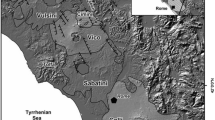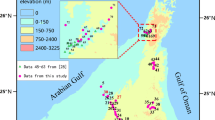Abstract
This study presents data of uranium (U) concentrations in groundwater (N = 155) and tap water (N = 4092) to which 76% of the entire German population has access. The mean U concentration was 0.68 μg/l, the median 0.50 μg/l. 3.7% of all samples had U concentrations below the detection limits, which accounts for water to which 11.7% of the entire population has access. 14.3% of samples were above 2 μg/l U, 3.3% above 10 μg/l U, representing an exposed population of 10.5 and 1.31% respectively. The regional distribution of U concentrations largely agrees with the geological setting reported for mineral waters, however, in addition clear evidence for anthropogenic influence through agricultural activities were found in certain areas.
Access this chapter
Tax calculation will be finalised at checkout
Purchases are for personal use only
Similar content being viewed by others
References
Alexander J, Benford D, Cockburn A, Cravedi JP, Dogliotti E, Di Domenico A, Férnandez Cruz ML, Fürst P, Fink-Gremmels J, Galli C, Grandjean P, Gzyl J, Heinemeyer G, Johansson N, Mutti A, Schlatter J, van Leeuwen R, Van Peteghem C, Verger P (2009) Scientific Opinion of the Panel on Contaminants in the Food Chain. EFSA Journal 1018: 1–59
Beyermann M, Bünger T, Gehrcke K, Obrikat D (2009) Strahlenexposition durch natürliche Radionuklide im Trinkwasser in der Bundesrepublik Deutschland. BfS, Salzgitter, Dezember 2009; urn:nbn:de:0221-20100319945
Birke M, Rauch U (2008) Uranium in stream water of Germany. In: de Kok L J, Schnug E (eds.) Loads and Fate of fertilizer-derived uranium. Backhuys Publishers, Leiden. ISBN/EAN 978-90-5782-193-6, 79–91
Birke M (2006) Geochemischer Atlas der Bundesrepublik Deutschland. Vorabinformationen Uran in http://www.bgr.de (18.2.2008)
Birke M, Rauch U, Lorenz H (2009) Uranium in stream and mineral water of the Federal Republic of Germany Environ Geochem Health 31: 693–706
Birke M, Demetriades A, De Vivo B, Eds. (2010) Special Issue: Mineral Waters of Europe. J Geochem Explor 107: i–viii + 217–422
BMELV – Bundesministerium für Ernährung, Landwirtschaft und Verbraucherschutz (1979/2007) Statistisches Jahrbuch über Ernährung, Landwirtschaft und Forsten. Landwirtschaftsverlag GmbH, Münster-Hiltrup
BMU – Bundesministerium für Umwelt (2011) http://www.bmu.de/binnengewaesser/trinkwasser/doc/3259.php
DIN (2004) Die Trinkwasserprobenahme (DIN 38402; Teil 14, 38411-1, EN 25667-1,2,3, BGesundhBl 3/2004: 296–300
Duijnisveld WHM, Godbersen L, Dilling J, Gäbler H E, Utermann J, Klump J and Scheeder G (2009) Ermittlung flächenrepräsentativer Hintergrundkonzentrationen priroritärer Schadstoffe in Bodensickerwasser. UBA-Forschungsbericht FKZ 20472264
El-Himri M, Pastor A, de la Guardia M (2000) Determination of uranium in tap water by ICP-MS. Fresenius J Anal Chem 367: 151–156
Fauth H, Hindel R, Siewers U, Zinner J (1985) Geochemischer Atlas Bundesrepublik Deutschland. Verteilung in Wässern und Bachsedimenten. Bundesanstalt für Geowissenschaften und Rohstoffe, Komm. E. Schweizerbart’sche Verlagsbuchhandlung, Stuttgart
Foodwatch (2008) Uran im Leitungswasser – gefährlich für Säuglinge, 4.8.08, http://www.foodwatch.de/kampagnen__themen/mineralwasser/trinkwasser/index_ger.html
Foodwatch (2009) http://www.foodwatch.de/kampagnen__themen/mineralwasser/ index_ger.html
Huhle B, Kummer S, Merkel B (2008) Mobility of uranium from phosphate fertilizers in sandy soils. In: de Kok LJ, Schnug E (eds.) Loads and Fate of fertilizer-derived uranium. Backhuys Publishers, Leiden. ISBN/EAN 978-90-5782-193-6, 47–56
Jaques D, Mallants D, Šimùnek J, Van Genuchten MT (2008) Modelling the fate of uranium from inorganic phosphorus fertilizer applications in agriculture. In: de Kok LJ, Schnug E (eds.) (2008) Loads and Fate of fertlizer-derived uranium. Backhuys Publishers, Leiden. ISBN/EAN 978-90-5782-193-6, 57–64
Knolle F (2008) Ein Beitrag zu Vorkommen und Herkunft von Uran in deutschen Mineral- und Leitungswässern, Dissertation, Technischen Universität Carolo-Wilhelmina zu Braunschweig, 161 pp., Digital Library Braunschweig 2009: www.digibib.tu-bs.de/?docid=00027200
Knolle F, Birke M, Hassoun R, Schnug E (2011) Uranium in German mineral waters – occurrence and origins. This volume
Popit A, Vaupotic J, Kukar N (2004) Systematic radium survey in spring waters of Slovenia. J Environm. Radioactivity 76: 337–347
Schäf M (2007a) Uran in Trinkwasserproben im Rhein-Neckar Gebiet, Diplomarbeit, Institut für Physikalische Chemie der Universität Heidelberg
Schäf M, Daumann L, Erdinger L (2007b) Uran in Trinkwasserproben im Rhein-Neckar Gebiet. Umweltmed. Forsch. Praxis 12: 315
Schnug E, Fleckenstein J, Haneklaus S (1996) Coca Cola Is It! The Ubiquitous Extractant for Micronutrients in Soil. Comm. Soil Sci. Plant Anal. 27: 1721–1730
Schnug E, Birke M, Costa N, Knolle F, Fleckenstein J, Panten K, Lilienthal H, Haneklaus S (2008) Uranium in German mineral and tap waters. In: de Kok LJ, Schnug E (eds.) Loads and Fate of fertilizer-derived uranium. Backhuys Publishers, Leiden. ISBN/EAN 978-90-5782-193-6, 91–110
Schulz C, Rapp T, Conrad A, Hünken A, Seiffert L, Becker K, Seiwert M, Kolossa-Gehring M (2008) Elementgehalte im häuslichen Trinkwasser aus Haushalten mit Kindern in Deutschland. Forschungsbericht 202 62 219 UBA-FB 001026. WaBoLu Hefte 04/08. ISSN 1862–4340, Dessau-Roßlau
Smidt GA, Landes FC, de Carvalho LM, Koschnisky A, Schnug E (2011) Cadmium and uranium in German and Brazilian phosphorous fertilisers. This volume
TWK (2008) Trinkwasserkommission des Bundesgesundheitsministeriums beim Umweltbundesamt, Stellungnahme der TWK zu einer Reihe häufig gestellter Fragen zu Uran im Trinkwasser, Online-Release: 3.11.08, http://www.umweltbundesamt.de/wasser/themen/trinkwasser/empfehlungen.htm
UBA – Umweltbundesamt (2008) Kinder-Umwelt-Survey 2003/06 Trinkwasser Elementgehalte im häuslichen Trinkwasser aus Haushalten mit Kindern in Deutschland. WaBoLu-Hefte 04/08, Forschungsbericht 202 62 219, UBA-FB 001026, Dessau-Roßlau
UBA – Umweltbundesamt (2009) Uran (U) im Trinkwasser: Kurzbegründung des gesundheitlichen UBA-Leitwertes (10 μg/l U) und des Grenzwertes für „säuglingsgeeignete“ abgepackte Wässer (2 ng/l U) http://www.umweltdaten.de/wasser/themen/trinkwassertoxikologie/ kurzbegruendunguran_leitwert.pdf
UNEP – United Nations Environmental Programme (2001) Depleted uranium in Kosovo – post conflict environmental assessment. United Nations Environmental Programme, Nairobi, Kenya
Utermann J, Fuchs M (2008) Uranium in German soils. In: de Kok LJ, Schnug E (eds.) (2008) Loads and Fate of fertilizer-derived uranium. Backhuys Publishers, Leiden. ISBN/EAN 978-90-5782-193-6: 33–46
Utermann J, Duijnsveld WHM, Godbersen L (2009) Uran in Böden und Sickerwässern – gibt es Indizien für eine Phosphordüngerbürtige UAnreicherung. Mitt. Dt. Bodenkdl. Ges. 19: 4 pp.
Vigelahn L, Schmoll O, Hermann HD, Chorus I (2010) Rund um das Trinkwasser. 88 pp., Dessau-Roßlau
Wu WM, Carley J, Green SJ, Luo J, Kelly SD, van Nostrand J, Lowe K, Mehlhorn T, Caroll S, Boonchayanant B, Löffler FE, Watson D, Kemner KM, Zhou J, Kitanidis PK, Kostka JE, Jardine PM, Criddle C (2010) Effects of nitrate on the stability of uranium in a bioreduced region of the subsoil. Environ Sci Technol 2010, 44, 5104–5111
WHO (2005) Uranium in drinking-water, Background document for development of WHO guidelines for drinking-water quality, WHO/SDE/WSH/03.04/118
Zielinski RA, Simmons KR, Oremn WH (2000) Use of 234U and 238U Isotopes to identify fertilizer derived uranium in the Florida Everglades Appl Geochem 15: 369–383
Zielinski RA, Oremand WH, Simmons KR, and Bohlen PJ (2006) Fertilizer-derived uranium and sulfur in rangeland soil and runoff: A case study in central florida. Water Air Soil Poll. 176: 163–183
Author information
Authors and Affiliations
Editor information
Editors and Affiliations
Rights and permissions
Copyright information
© 2011 Springer-Verlag Berlin Heidelberg
About this chapter
Cite this chapter
Smidt, G. et al. (2011). Uranium in German Tap and Groundwater – Occurrence and Origins. In: Merkel, B., Schipek, M. (eds) The New Uranium Mining Boom. Springer Geology. Springer, Berlin, Heidelberg. https://doi.org/10.1007/978-3-642-22122-4_93
Download citation
DOI: https://doi.org/10.1007/978-3-642-22122-4_93
Publisher Name: Springer, Berlin, Heidelberg
Print ISBN: 978-3-642-22121-7
Online ISBN: 978-3-642-22122-4
eBook Packages: Earth and Environmental ScienceEarth and Environmental Science (R0)




